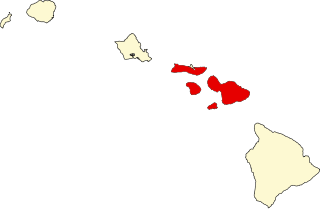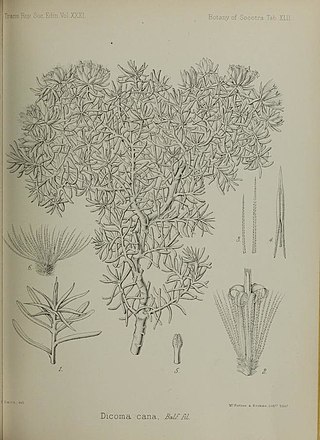
Maui Nui is a modern geologists' name given to a prehistoric Hawaiian island and the corresponding modern biogeographic region. Maui Nui is composed of four modern islands: Maui, Molokaʻi, Lānaʻi, and Kahoʻolawe. Administratively, the four modern islands comprise Maui County. Long after the breakup of Maui Nui, the four modern islands retained plant and animal life similar to each other. Thus, Maui Nui is not only a prehistoric island but also a modern biogeographic region.

The conservation status of a group of organisms indicates whether the group still exists and how likely the group is to become extinct in the near future. Many factors are taken into account when assessing conservation status: not simply the number of individuals remaining, but the overall increase or decrease in the population over time, breeding success rates, and known threats. Various systems of conservation status exist and are in use at international, multi-country, national and local levels as well as for consumer use.

Streblorrhiza was a monotypic genus of legumes in the family Fabaceae. Its only species was Streblorrhiza speciosa, a perennial shrub endemic to Phillip Island. It is now presumed extinct.
Clibadium laxum, synonym Clibadium alatum, is a species of flowering plant in the family Asteraceae. It is native to Colombia and Ecuador. In Ecuador, its natural habitats are subtropical or tropical moist lowland forests and subtropical or tropical moist montane forests.
Clibadium sodiroi, synonym Clibadium mexiae, is a species of flowering plant in the family Asteraceae. It is native to Colombia and Ecuador. In Ecuador, its natural habitats are subtropical or tropical moist lowland forests and subtropical or tropical moist montane forests.
Clibadium glabrescens, synonym Clibadium napoense, is a species of flowering plant in the family Asteraceae. It is native to Colombia, Ecuador and Venezuela. In Ecuador, its natural habitat is subtropical or tropical moist lowland forests.
Clibadium pentaneuron, synonym Clibadium zakii, is a species of flowering plant in the family Asteraceae. It is native to Colombia and Ecuador. In Ecuador, its natural habitat is subtropical or tropical moist montane forests.

Macledium canum, synonym Dicoma cana, is a species of flowering plant in the family Asteraceae. It is endemic to Socotra. Its natural habitats are subtropical or tropical dry shrubland and plantations.

Dicoma is a genus of flowering plants in the family Asteraceae, native to Africa and the Middle East.
Pseudognaphalium gaudichaudianum, synonyms including Gnaphalium imbaburense and Gnaphalium sodiroi, is a species of flowering plant in the family Asteraceae. It is widely distributed in South America, from Colombia in the north to southern Argentina.

Frithia pulchra, the fairy elephant's feet, is a species of flowering plant in the fig‑marigold family Aizoaceae, endemic to Gauteng Province, South Africa. Its natural habitat is temperate grassland with high summer rainfall. A tiny stemless succulent growing to just 10 cm (3.9 in) tall and 20 cm (7.9 in) broad, it has bulbous oblong leaves with leaf windows at the tip; and magenta and white daisy-like flowers in winter. During periods of drought it has the ability to shrink beneath the soil surface, thus avoiding excessive desiccation, but making it extremely difficult to find.
Gladiolus pole-evansii is a species of plant in the family Iridaceae. It is endemic to the Mpumalanga province of South Africa. Its natural habitat is subtropical or tropical dry shrubland.
Karomia gigas is a species of plant in the family Lamiaceae. It is found in Kenya and Tanzania, where only small populations survive.
Ochrosia brownii, synonym Neisosperma brownii, is a species of plant in the family Apocynaceae. It was endemic to the Marquesas Islands in French Polynesia and is extinct in the wild.
Trachyandra erythrorrhiza is a species of plant which is endemic to the province of Gauteng in South Africa. Its natural habitat is intermittent freshwater marshes. It is threatened by habitat loss.
Euphorbia remyi is a rare species of flowering plant in the family Euphorbiaceae. It is known by the common name Remy's sandmat locally as ʻakoko. It is endemic to the island of Kauaʻi in Hawaii, where it grows in mixed mesic forests, wet forests and bogs from 150 to 900 m.

Macledium is a genus of flowering plants in the family Asteraceae. Both Macledium and Dicoma are distributed largely in tropical and southern Africa. Macledium is distinguished from genus Dicoma by a large number of characters relating to morphology and anatomy of phyllaries, corolla, anthers, style, cypsela and testa.

Macledium spinosum is a variable species of flowering plant in the family Asteraceae, that is endemic to the southern Cape regions of South Africa.

Trilepidea is a extinct monotypic genus of flowering plants belonging to the family Loranthaceae. Its native range was New Zealand. The only species was Trilepidea adamsii, or Adams mistletoe. It was first described in 1880 as Loranthus adamsii and has ever only been collected from a few locations in the North Island. It has been argued that the extinction of this species, vulnerable due to restricted distribution, was caused by interaction of a number of factors, including introduction of an exotic species, in this case the brushtail possum from Australia.









